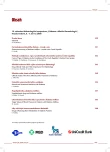Pharmaceutical Care of Patients with Diabetes Mellitus and Its Relationship to Clinical Pharmacy
Authors:
J. Vlček; J. Malý; M. Doseděl
Authors‘ workplace:
Katedra sociální a klinické farmacie Farmaceutické fakulty UK Hradec Králové, přednosta prof. RNDr. Jiří Vlček, CSc.
Published in:
Vnitř Lék 2009; 55(4): 384-388
Category:
Overview
Introduction:
Pharmaceutical care develops both at universities in the Czech Republic and in daily practice, and is focused on
drug-related issues as a pharmacist has the broadest knowledge of the drug and offers such knowledge to other persons involved in patient care. Pharmaceutical care is part of health care and although the pharmacist is considered to be a health service officer by legislation, health insurance companies – probably due to the fact the pharmacist is paid based on the margin obtained in business activities from the purchase and sale of prescribed drugs – do not see the pharmacist as such and they need to be convinced that such activity is necessary for the patient and is positive within the medical team. The aim of the article is to define what pharmaceutical care is, where it can be provided, why it is necessary within medical and nursing care, and to point out drug-related issues occurring in diabetic patients as well as the method for identifying and resolving them.
Method:
The method is the answer to the following questions: Where to class pharmaceutical care and how to define the knowledge preconditions for such activity? Where is pharmaceutical care provided and what is its objective? How and where is pharmaceutical care taught? How can pharmaceutical care be applied in diabetology? The answers to the questions raised are based on literature and the authors’ own teaching experience and activities performed in the position of clinical pharmacist at the 2nd Department of Internal Medicine of the University Hospital in Hradec Králové. Another method was the analysis of the incidence of
drug issues related to the prescription of antidiabetics identified by 66 pharmacists over 2 months of active recording of drug-related issues and detected in hospitalized patients of the 2nd Department of Internal Medicine, both in outpatient and inpatient care. Another method was the monitoring of physicians’ opinions about the doctor - pharmacist cooperation in the form of an interactive lecture at the spring congress of physicians in Prague in 2008.
Results:
The basic method of pharmaceutical care is the maximization of benefits (instructions, how to use the drug correctly, how to support the patient’s compliance, change in lifestyle) and the minimization of risks (to look for risk signals and to help resolve them; to resolve them directly with the OTC drug). Pharmacists can do this, in particular, if they are educated in clinical pharmacy and have sufficient training in pharmaceutical care – which nowadays is not an inaccessible activity. Pharmacists have identified, within the analysis of drug-related mistakes, 38 drug issues related to antidiabetics – which represent approximately 3 percent of all detected drug-related issues. The following problems were identified in diabetic patients at the 2nd Department of Internal Medicine: high doses of hydrochlorothiazide administered to diabetic patients, the administration of beta-blockers to diabetic patients with hypoglycemic attacks, the administration of metformin to a patient with malfunctioning kidneys, the reduction of corticoids without sufficient diabetes control. Most of the interviewed physicians (approx. 200) supported active cooperation with pharmacists not only in economic but also in professional issues.
Conclusion:
A pharmacist is able, within pharmaceutical care, to identify the first signs of the disease and to recommend the patient for a medical examination. He can detect drug-related issues thus minimising risks. He can maximise the effect by supporting drug compliance, repeating instructions for use of the drug and recommending a change in lifestyle; he can also help detect and minimise the impact of various risk factors. All these activities (in the strategic alliance of doctor – patient – pharmacist) can reduce
the incidence of complications, which are expensive for the payers and reduce the quality of the patient’s life.
Key words:
pharmaceutical care – diabetes mellitus – clinical pharmacy – risk minimization – effect maximization
Sources
1. Crotty M, Rowett D, Spurling L et al. Does the addition of a pharmacist transition coordinator improve evidence‑based medication management and health outcomes in older adults movin from the hospital to long‑term care facility? Results of a randomized, controlled trial. Am J Geriatr Pharmacother 2004; 2 : 257–264.
2. Heneghan C, Alonso-Coello P, Garcia-Alamino JM et al. Self-monitoring of oral anticoagulation: a systematic review and meta‑analysis. Lancet 2006; 367 : 404–411.
3. Leichter SB. Making Outpatient Care of Diabetes More Efficient: Analyzing Noncompliance. Clin Diabet 2005; 23 : 187–190.
4. Muijers PE, Knottnerus JA, Sijbrandij J et al. Changing relationships: attitudes and opinions of general practitioners and pharmacists regarding the role of community pharmacist. Pharm World Sci 2003; 25 : 235–241.
5. Paulino EI, Bouvy ML, Gastelurrutia MA et al. Drug related problems identified by European community of pharmacists in patient discharged from hospital. Pharm World Sci 2004; 26 : 353–360.
6. Storimans MJ, Klungel OH, Talsma H et al. Collaborative services among community pharmacies for patients with diabetes. Ann Pharmacother 2005; 39 : 1647–1653.
7. http://www.pcne.org. Pharmaceutical care network Europe – Drug related problem classification.
Labels
Diabetology Endocrinology Internal medicineArticle was published in
Internal Medicine

2009 Issue 4
Most read in this issue
- Target Values of Blood Pressure in Patients with Diabetes Mellitus
- Drug Interactions of Selected Drugs Used by Patients with Diabetes Mellitus
- Options of Hormonal Contraceptives and Substitution in Female Diabetic Patients
- Insulin Sensitizing Drugs
